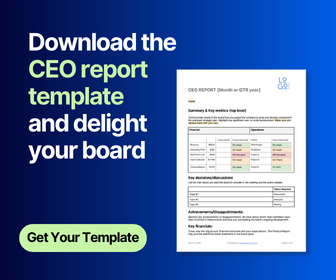Your Board Papers are vitally important. They prepare the board for the decisions that must be made and provide the board with the information they need to discharge their duty of oversight. Of all the Board Papers the CEO report is probably the most important.
Experienced directors will turn to and read this paper first. It sets the context for every other paper in the pack.
As such, it's a wonderful opportunity to prepare your board to be totally effective during the upcoming meeting.
However, many CEOs struggle, when faced with the tyranny of a blank screen, to put down their thoughts in a compelling and clear fashion that will engage the board and help to prepare them for a highly effective meeting.
Ideally your board report should serve two purposes:
- to inform the board of the key changes that have occurred during the period since the last board meeting
- to engage the board in providing advice and assistance to the CEO
Whilst many CEO reports do a good job with the first objective, most CEOs struggle with the second simply because they do not wish to put on record the areas that they are finding difficult. But here’s the problem, directors find it hard to read a report that is packed with information but that has no call to action or stimulus for creative thinking. Directors greatly prefer a report that has something in it for them to do.
Let’s look at each function in turn. And then let’s explore some tips to help you write quickly, effectively, and succinctly.
The Information Function
Start with a brief overview of how you believe the organisation has performed, what are the most important issues facing it at the moment, and the likely future prospects. Try to keep this in one or two brief paragraphs. Then use headings to take a more detailed look at individual projects and issues within this context.
Ideally the CEO report should focus on just a few key important issues and items. Resist the temptation to stuff it full of everything that has been occupying your time. If you want to convey how your time is spent place a one-page list, calendar view, or block diagram of your key diary engagements at the end of the report. This can be historical, forward-looking, or both.
Only cover items that do not have a paper elsewhere in the board pack. If you want to remind the board of the importance or the progress of an item that is covered elsewhere, simply list it as a heading and then state, ‘see paper at item “X” of this pack’. Don’t repeat, summarise, or extend information that is reported elsewhere.
Only cover items that are strategically important. Matters of lesser import can be conveyed elsewhere in the board pack, placed in a secure information portal for directors to inform themselves if they wish, or simply omitted. Omitting items of lesser import allows more space for providing context for the items that are strategically important.
Provide a brief status report on all key projects, any important litigation, and any interactions with key stakeholders. The simplest way to decide if information is ‘strategic’ or ‘key’ is to place yourself in the board’s shoes (metaphorically) and ask yourself, “if I were accountable for the long-term viability and health of this company, rather than the day-to-day management of this company, would I want or need this information?”
If you find you are still having difficulty deciding what is ‘key’ or ‘strategic’, draw up a framework and ask the board to agree on how you should determine what makes the cut and what doesn’t.
You may find that a graphical ‘dashboard’ or numerical portrayal helps to convey the situation more easily than a paragraph of text. Diagrams, charts, and graphs are very useful tools for communicating a lot of information succinctly.
Consider where the finance report is placed in your board papers. If it is part of the CEO report, then cover it fully and make sure that your report clearly conveys how each topic impacts the financial results. If there is a separate finance report, prepared by a CFO or Treasurer, then make sure you prepare the CEO report in plenty of time so that you and the person preparing the finance report can sit together and go through the two reports to identify where they overlap or appear to contradict.
What happens if you, as CEO disagree with how the person preparing the finance report wants to report or characterise information? Hopefully nothing bad!
Accounts are often a matter of judgement such as: when to recognise revenue, when a contingency should be taken, whether to provide for future events, what an asset might be worth under different scenarios, etc. If your judgements differ and you can’t agree on a way of stating something in the accounts, simply write a brief explanation of the issue and ask the board to decide on the treatment they wish to see in their accounts. For a complex or potentially contentious issue you might need to get an external expert, such as your auditor, to assist.
When you are satisfied that your report covers everything that is needed, it is time to think about engaging the board to assist you with decisions or to build some shared views of events and prospects.
The Engagement Function
Being CEO is one of the loneliest jobs in the world. You are required to demonstrate leadership even under uncertainty, or – indeed – especially under uncertainty. The board should be your strongest allies in making sense of the complex environment and providing a clear sense of purpose and direction.
The CEO report is an excellent opportunity to solicit board engagement on the issues that are taxing you and your leadership team. It is also the platform for building support for your ongoing initiatives and helping to keep the board enthused.
Be sure to include actionable recommendations on any items that require a decision. Your board should be reading with a view to either forming an opinion or making a decision. If they become passive and read merely out of interest or because it is given to them, they will likely miss things as they gloss over what seems to them to be irrelevant detail. Avoid having a lengthy list of ‘For Noting’ items, instead use for discussion, seeking input, or for decision.
Make sure that every piece of information earns its place in your report. It should always be something that the board will either incorporate into their thinking or use to make a decision.
To be truly engaging the report needs to focus on the key items that impact the strategic success of the company and to make those items relevant to the directors. A great structure will help to engage.
There are many different ways in which to order your material. It is more effective to design a suitable structure and then to place the material into that structure rather than to gather the material and then rearrange it in the hope that one of your arrangements will miraculously make sense. Some of my favourite structures are:
- Threes – Three main topics each with three subheadings each with about 3 paragraphs of text. People can remember threes very easily. It is also good to foreshadow ‘there are three key points ...” as then your readers will concentrate on all three. Many politicians use this structure. A beginning, middle and end, are a prime example of a simple ‘three’ structure.
- The middle ground – this is a great structure for justifying a choice. You outline three possibilities, the two ‘outliers’ are each unacceptable for one reason or another and so the middle option becomes the preferred option. For example “we could provide a Hyundai Getz for our CEO but it might not be big enough if he had to drive customers, we could also provide a Mercedes which would confer status but may give the impression that we will charge high fees, therefore we have decided that the CEO should drive a Holden Statesman which will confer status without being extravagant.”
- Concentric circles – zeroing in on an action or extrapolating out from it are also persuasive structures. For example “if our maintenance workshop is untidy customers may think that we don’t pay attention to detail, that would infer that we might do a poor job and they would take their business elsewhere, therefore we will require the fitters to tidy their workplaces before they leave each evening.”
Having a structure will help you to edit the material. Anything that does not logically fit in the structure should be left out. Do not distort the clarity of your structure to include additional data. Place extraneous data elsewhere under a heading that identifies it as an item that should be monitored to ensure that it remains superfluous.
Think also about including elements in your structure that will make the report appealing to the different communication styles of your diverse board.
Summarising
I like to write my summary first. It then serves as a guide for writing the text of the paper itself.
If you have already written the paper (or had someone write it for you) and need to add a summary there are a few ways to do this easily. Start by putting yourself in the readers’ place. What do they most need to know? What are the key points that they will surely use to make their decisions? What are the biggest risks that they may wish to consider? Who might be impacted?
Remember that a summary doesn’t mean you can be profligate with your words elsewhere! Write what you need to say and then refine your writing until it is brief and clear.
Share this
You May Also Like
These Related Stories
%20(1).png)
What should a CEO report to the board?

Create your annual CEO report
%20(1).png)

